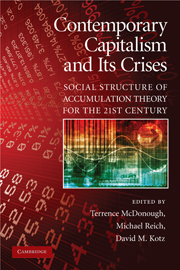Book contents
- Frontmatter
- Contents
- List of Tables
- List of Figures
- List of Contributors
- Acknowledgments
- Introduction: Social Structure of Accumulation Theory for the 21st Century
- PART I THE THEORY OF SOCIAL STRUCTURES OF ACCUMULATION
- PART II GLOBALIZATION AND THE CONTEMPORARY SOCIAL STRUCTURE OF ACCUMULATION
- PART III THE CONTEMPORARY SOCIAL STRUCTURE OF ACCUMULATION IN THE UNITED STATES
- 8 Labor in the Contemporary Social Structure of Accumulation
- 9 The Rise of CEO Pay and the Contemporary Social Structure of Accumulation in the United States
- 10 Social Structures of Accumulation and the Criminal Justice System
- PART IV SOCIAL STRUCTURE OF ACCUMULATION THEORY AND TRANSFORMATIONS OF THE CAPITALIST PERIPHERY
- Index
- References
10 - Social Structures of Accumulation and the Criminal Justice System
Published online by Cambridge University Press: 05 June 2012
- Frontmatter
- Contents
- List of Tables
- List of Figures
- List of Contributors
- Acknowledgments
- Introduction: Social Structure of Accumulation Theory for the 21st Century
- PART I THE THEORY OF SOCIAL STRUCTURES OF ACCUMULATION
- PART II GLOBALIZATION AND THE CONTEMPORARY SOCIAL STRUCTURE OF ACCUMULATION
- PART III THE CONTEMPORARY SOCIAL STRUCTURE OF ACCUMULATION IN THE UNITED STATES
- 8 Labor in the Contemporary Social Structure of Accumulation
- 9 The Rise of CEO Pay and the Contemporary Social Structure of Accumulation in the United States
- 10 Social Structures of Accumulation and the Criminal Justice System
- PART IV SOCIAL STRUCTURE OF ACCUMULATION THEORY AND TRANSFORMATIONS OF THE CAPITALIST PERIPHERY
- Index
- References
Summary
Introduction
Social structure of accumulation (SSA) theory posits that at particular historical moments a unique set of economic, political, and social institutions come together to provide the conditions necessary for a period of sustained, vigorous capital accumulation, particularly by regulating class conflict and competition (Kotz 1987). Gordon, Edwards, and Reich (1982: 25) further suggest that “… different social structures of accumulation may incorporate (or exclude) differing sets of social institutions” with a tendency of the institutional ensemble to become more complex and include more institutions over time.
To date, SSA analyses of the post-World War II SSA in the United States have been limited to the four pillars that comprise the SSA – limited capital-labor accord, capital-citizen accord, pax Americana, and containment of inter-capitalist rivalry (Bowles, Gordon, and Weisskopf 1990) – or “core institutions” (Kotz 1987; McDonough 1994) that impinge most directly on the accumulation process. Scant attention has been given to other institutions that may play an important supportive role in facilitating capital accumulation.
This chapter provides an analysis of one such institution – the criminal justice system – across phases of the post-World War II SSA in the United States. Several SSA authors have discussed prisons and the new “garrison state” (Bowles, Gordon, and Weisskopf 1990; Gordon 1996), rising expenditures on the criminal justice system (Lippit 1997), and the war on drugs (Houston 1992) as characterizing the most recent phase of the post-World War II SSA, but none have theorized the role of the criminal justice system in the capital accumulation process.
- Type
- Chapter
- Information
- Contemporary Capitalism and its CrisesSocial Structure of Accumulation Theory for the 21st Century, pp. 239 - 264Publisher: Cambridge University PressPrint publication year: 2010
References
- 4
- Cited by



